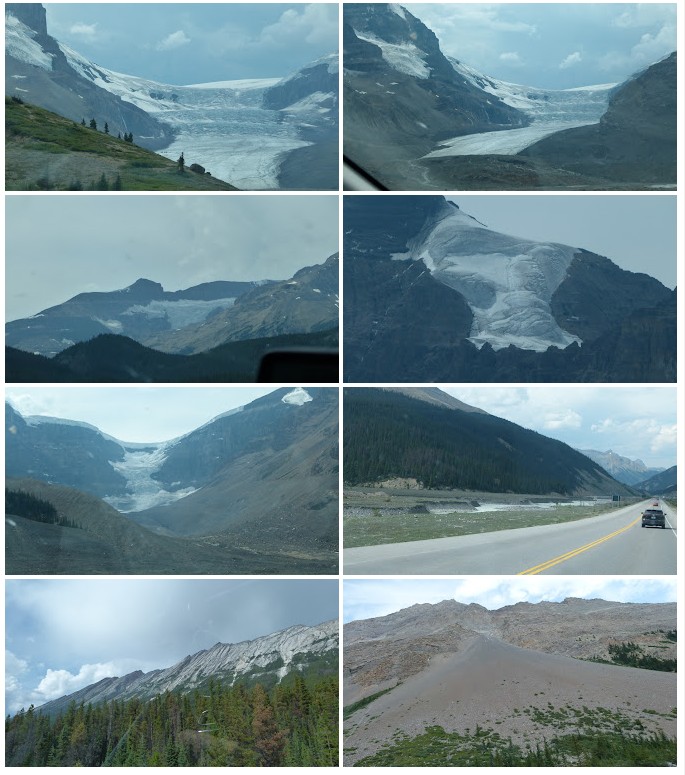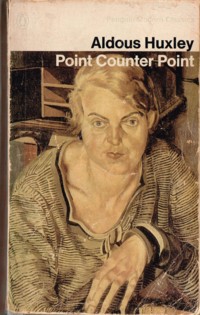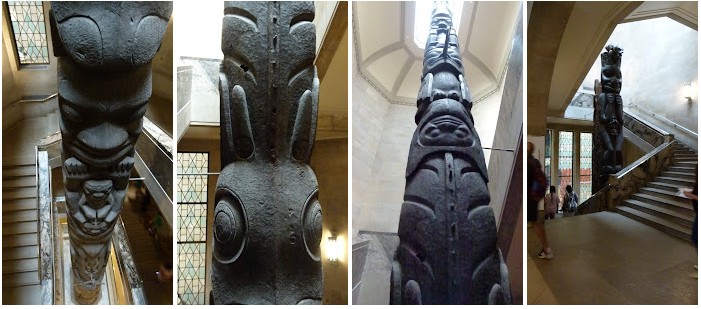In July and August 2023 Wendy and I travelled to the United States again after a six-year gap. Back in 2007 we visited the east coast and west coast and in 2017 we visited 'the middle bits', travelling down from Chicago via Memphis to New Orleans then west across Texas, New Mexico, Nevada and California on our way home.
So, this time we went north from Los Angeles to Seattle, Washington, and then into Canada. From Vancouver we travelled by car, over the Rockies, then flew east to Toronto where we hired a car to travel to Ottawa and Montreal. Our next flight was all the way down to Miami, Florida, then to Fort Lauderdale, where we joined a western Caribbean cruise. At the end of the cruise, we flew all the way back up to Boston.
Seems crazy but that was the most economical option. From Boston we hired another car to drive, down the coast, to New York. After New York we flew to Salt Lake City then on to Los Angeles, before returning to OZ.
As usual, save for a couple of hotels and the cars, Wendy did all the booking.
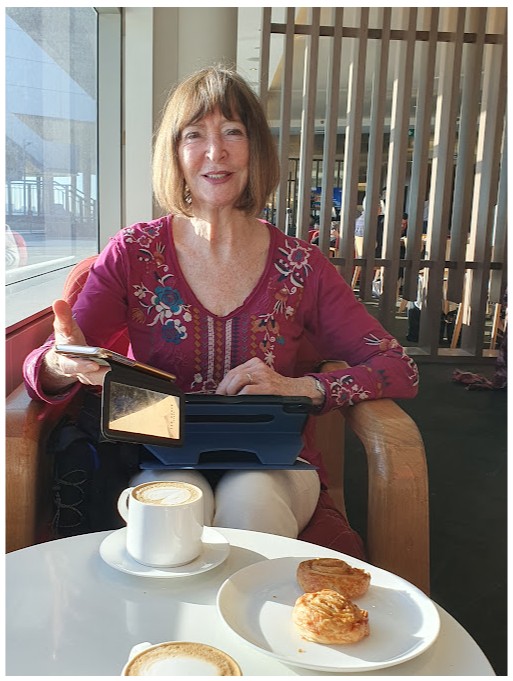
Breakfast in the Qantas lounge on our way to Seattle
Wendy likes to use two devices at once
Our first stop was Los Angeles but it was just a stopover on the way to Seattle.
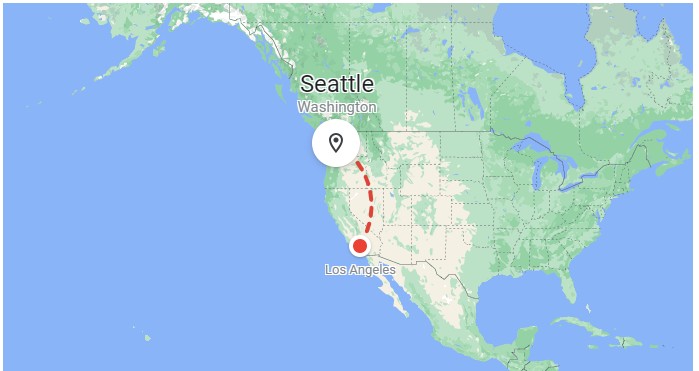
Here we are in Seattle. And what else does one do in Seattle? Why, visit the iconic Space Needle and go out to the Boeing plant and the Museum of Flight.
The Space Needle, built for the 'Seattle World Fair' in 1962, was briefly the tallest structure west of the Mississippi. Now, its height is unremarkable, it's shorter, even, than Sydney's Centrepoint Tower.
Initially we couldnt see it, it was hidden behind the city's many office towers. But it does have a thrilling glass floor that rotates like the restaurant at Centrepoint in Sydney. Indeed, this floor was once opaque, it was a restaurant too.
Of course, once you are above a hundred or so metres acrophobia kicks-in, so the adrenaline thrill, for those not yet accustomed to the appearance of nothing beneath their feet, is just as potent, as the squeals, from some, and white faces, on others, attest. In this respect, this glass floor is just as scary, as the glass floor areas at the Tokyo Tower, not to mention the very much higher outward leaning walls at the Willis Tower, in Chicago.
'The Space Needle' was constructed at the height of the 'space-race', that began a decade earlier. Its unique shape came to symbolise the era, referenced in the 'Jetsons' TV show.
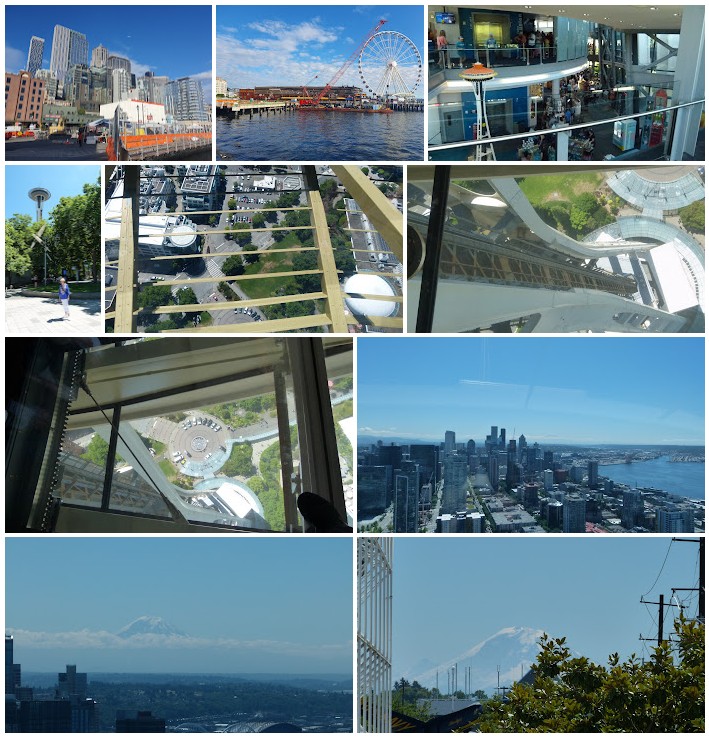 Looming over the southern horizon is Mount Rainier (Tahoma) an active stratovolcano
Looming over the southern horizon is Mount Rainier (Tahoma) an active stratovolcano
Its peak is 4.4 kilometres above sea level - and like other large 'free standing' mountains it's truly impressive
The 'space-race' had began with the Russian 'Sputnik' satellite in 1952; followed by Laika in 1957, the first dog in space, on Sputnik 2. The USSR then leapt ahead in 1961 when Yuri Gagarin, became the first Cosmonaut.
The American program, initially based on the German V-2 rocket, and directed by ex-Nazi, Wernher Von Braun, had faltered from one disaster to another, until 1962 when newly elected President Kennedy, who had been critical of the program in opposition, declared that the goal was now to: "walk on the Moon by the end of the decade". America just made it in time, with that "one small step for (a) man...", in July 1969.
Of course, the real concern was mutually assured destruction. Space supremacy was essential in the event of nuclear war. How else could we wipe out those Ruskies, before they got us?
| "Once the rockets are up, who cares where they come down..." |
So, the competition with Russia continued. And now others had joined the race. For example, Australia that had shared a military rocket and atomic bomb program with the UK, launched its own satellite in 1967, using reassembled rocket components from the US and UK.
Yet, as we saw in Houston on our last trip to America, that early competition finally came to an end with cooperation; to build and staff the International Space Station.
The NASA Houston International Space Station Control Room
showing the ISS live with a Russian crew member on camera
Click on this picture to see more
On a similar theme, a little out of town, to the south, we could tell it by the mountain, is the Museum of Flight. This houses an amazing collection of historic aircraft from many countries, both allied and combatant, as many are military. There are also many commercial aircraft, mainly from the Boeing stable, including an old Air Force One. They also have a supersonic Aérospatiale/BAC Concorde that, like many of the aircraft here, is open for inspection. Very interesting.
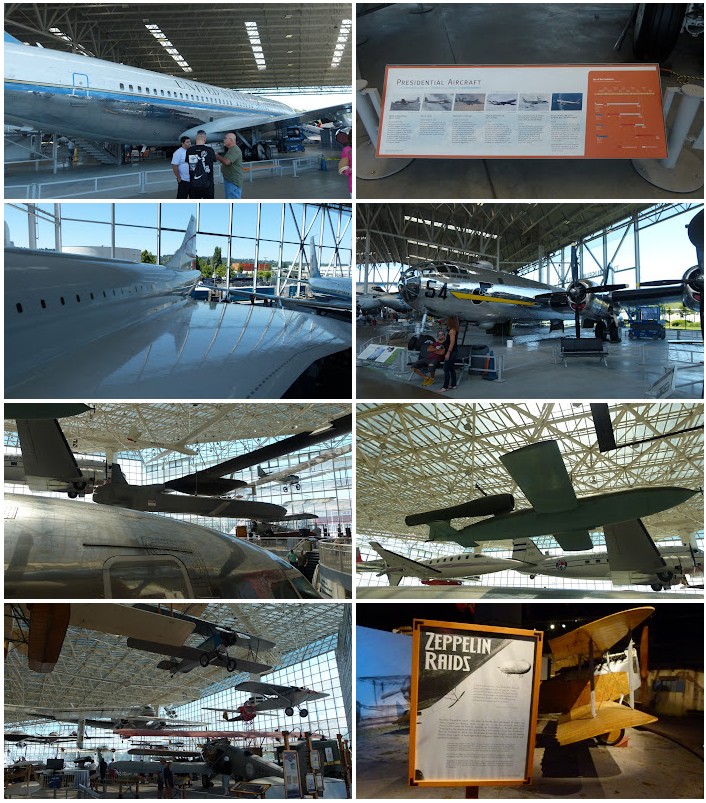 Of special interest was the collection of pilotless aircraft, beginning with the German V1 'buzzbomb'
Of special interest was the collection of pilotless aircraft, beginning with the German V1 'buzzbomb'
with other examples, through to the present generation of US drones.
These have remote pilots. But now onboard AI is making them semi of fully autonomous.
It's easy to predict that most military aircraft will soon be pilotless, because a huge proportion of their cost;
and major limit on their manoeuvrability; is just to keep their encapsulated human alive.
To get to Vancouver we caught the bus. The international bus terminal is conveniently connected with the metro, in turn to our hotel, where it was most useful and convenient.
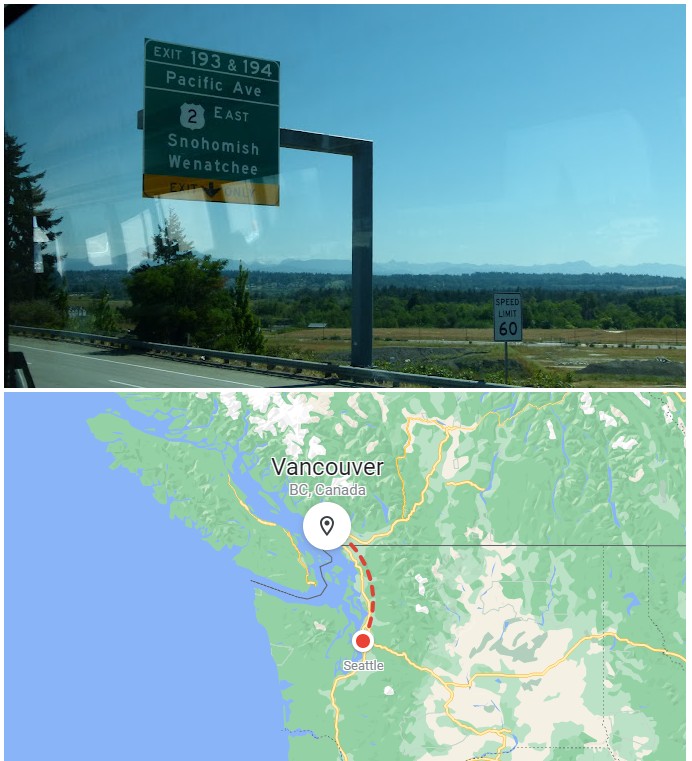
We spent most of our first afternoon walking over to the Museum of Vancouver and, after looking at the exhibits, walking back for coffee, near our hotel.
The Museum explains that this was/is aboriginal land and shows how sophisticated the inhabitants were, with some very finely crafted stone tools.
In a later gallery we learn that Vancouver, like Sydney went through planning protests to arrive at today's very liveable compromise.
The following day we took a bus trip into the suburbs only to be deterred from going further by the first heavy rain they had had for some time. We even encountered a camera-crew filming the rain for the local news.
When the rain stopped, we hopped off the bus, down by the bay, and walked to a coffee shop where horse drawn wagons carried people around the park, before another long walk back.
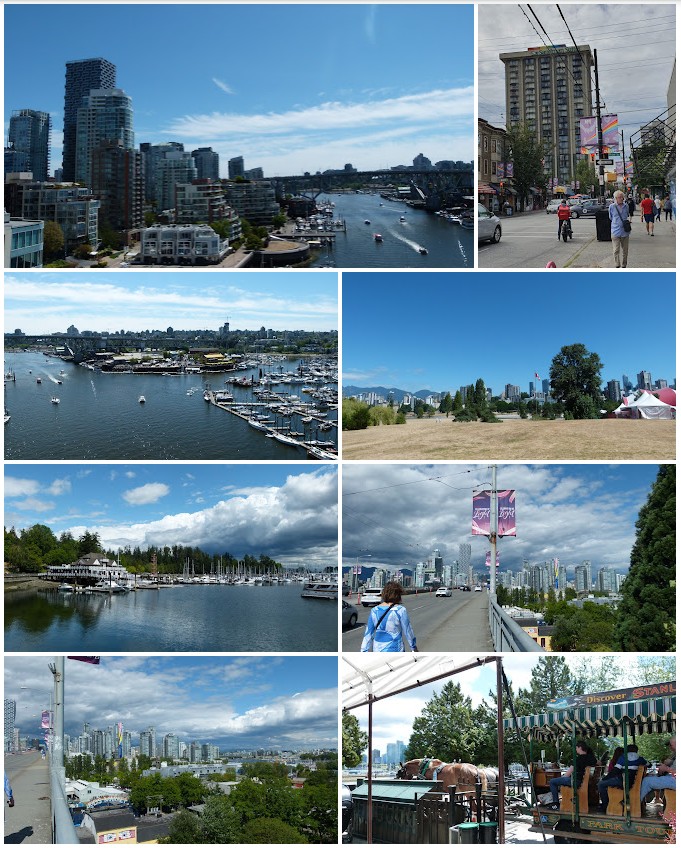
To call Vancouver the Paris of North America would be to insult Vancouver. We were most impressed.
On our final day here we picked up a (pre-ordered from OZ) car to drive across the Rockies to Calgary. On the way we would collect our friends Brian and Kat, so we needed plenty of luggage space.
Our first overnight stop was at the ski-resort town of Kamloops.
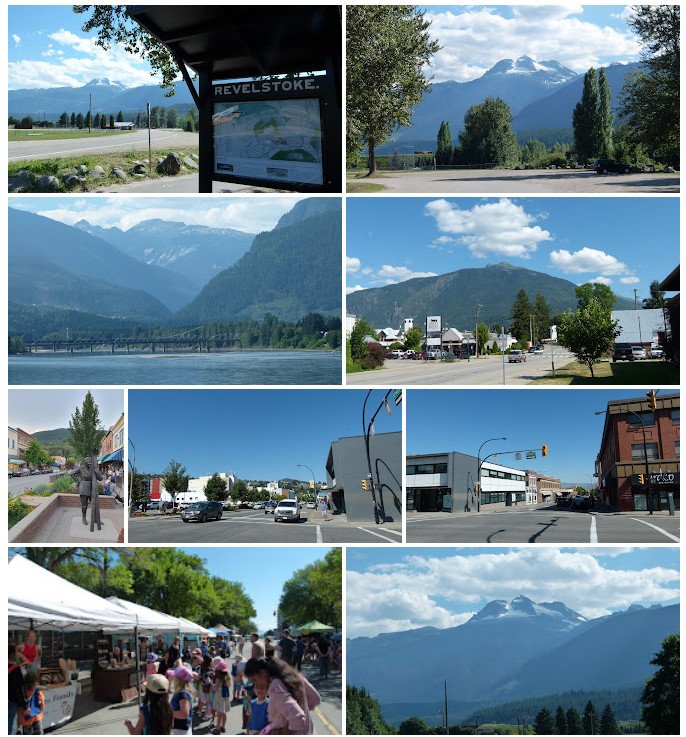
Kamloops has a couple of pubs, one of which seemed a possible solution for an inexpensive meal. It was a Canadian version of an Australian outback pub, complete with local workers and 'characters'.
The restaurant at the hotel was closed, so we walked around town and checked-out the restaurants. The Pub looked better and better. Maybe the ciders were beaconing? In the end it was a good night.
Our next overnight stop would be Revelstoke.
Again, we walked, past the RCMP (Mounties) station, to the river and the more intimate vistas to be see there. There is an unmistakable similarity to the scenery in the Netflix soapy Virgin River. This is not surprising, as the series, that is supposed to take place in a remote 'Northern California' town, is actually shot, not far away from here, in Canada.
The following morning there was a local market set-up in the street, next to our hotel, that elicited a quick look.
After breakfast we set off again, to collect our friends Brian and Kat, an hour late as we had not realised that it's a new time zone, and then on to Banff where we needed to call in to Hertz to get Brian registered as a co-driver for the car.
Brian's less likely to forget which side of the road to drive on, as they live in California. Actually, I've more often forgotten in Australia, after returning from driving oversees. Less attention paid at home.
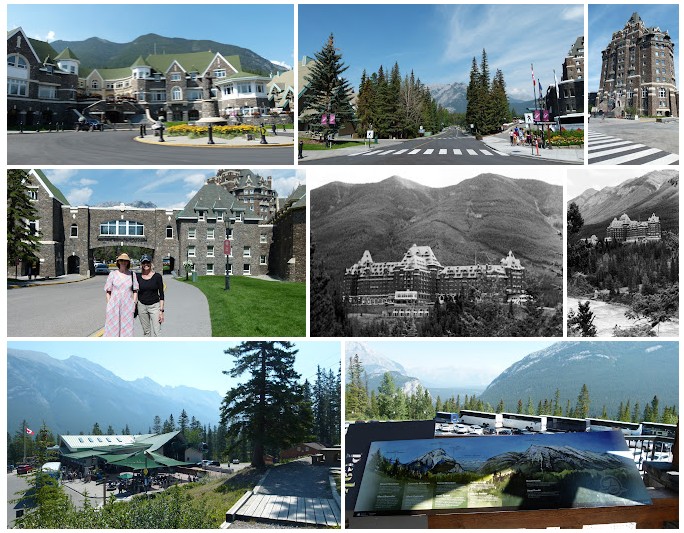
The Hertz office happens to be at the Fairmont, Banff Springs.
This turns out to be, unexpectedly, relevant to me and my successors, as, after getting out their Canadian photo album after the trip, it turns out that my parents were here, at this hotel in 1943.
I'm not sure if they stayed here but there's a picture of my mother leaning against an archway here and two photos of the hotel at a distance, taken by my father.
They were newly married and living in Calgary at the time and as the album reveals, came to Banff when my father was on leave from the Royal Air Force, Empire Air Training Scheme, where he was a flying instructor.
My mother became pregnant but lost the baby in Canada. This exact history is how I came to be born; when I was; how I came to live in Australia; and how my children and grandchildren exist at all.
Under the Empire Air Training Scheme (EATS) tens of thousands aircrew were trained to fight in Europe. Australia, New Zealand, South Africa, etc recruited suitable young men to undertake elementary training, after which promising candidates were sent to Canada for advanced training, before being deployed to the UK.
Like Australia, Canada was, at the time, a Dominion of the British Empire. Canada also had suitable training space, beyond the range of enemy aircraft, as well as excellent climatic conditions for flying. It was also adjacent to American industry and had its own aircraft building capacity. Unlike Australia, it was close enough to Britain to quickly transport men and aircraft, using established North Atlantic shipping lanes.
As a result, my parents met many Australians and liked them.
Then, in Canada, my father suffered a second back injury, when another aircraft smashed into his on the runway. He'd previously been injured in a combat related a 'prang' in England. This second injury, which plagued him for the rest of his life, caused my parents to look for a warmer climate, and Australia here we came.
I knew they had been to Banff. Yet, I was not aware of the importance of this place to my very existence when we came here.
It was thanks to Hertz that we discovered that the Fairmont has an excellent coffee shop, open to the public. So, it was from yet a different hotel in Banff, that we all came here again, after our trip up to Jasper.
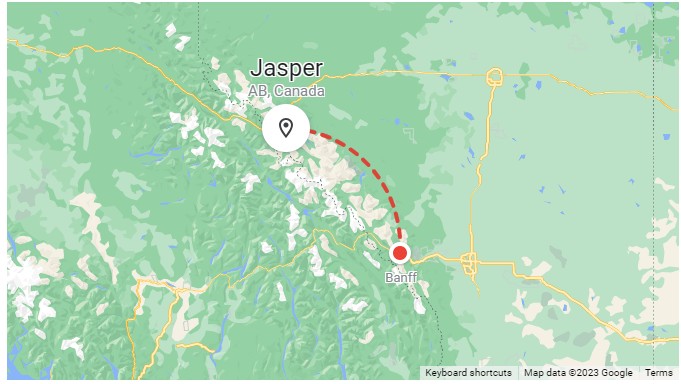
The Jasper National Park has some of the most spectacular scenery we have ever seen - challenging Tajikistan and the Himalayan foothills. But here there are glaciers by the dozen!
There's geology enough to convert the most committed creationist. Amazing! A must see. Photos don't do it justice.
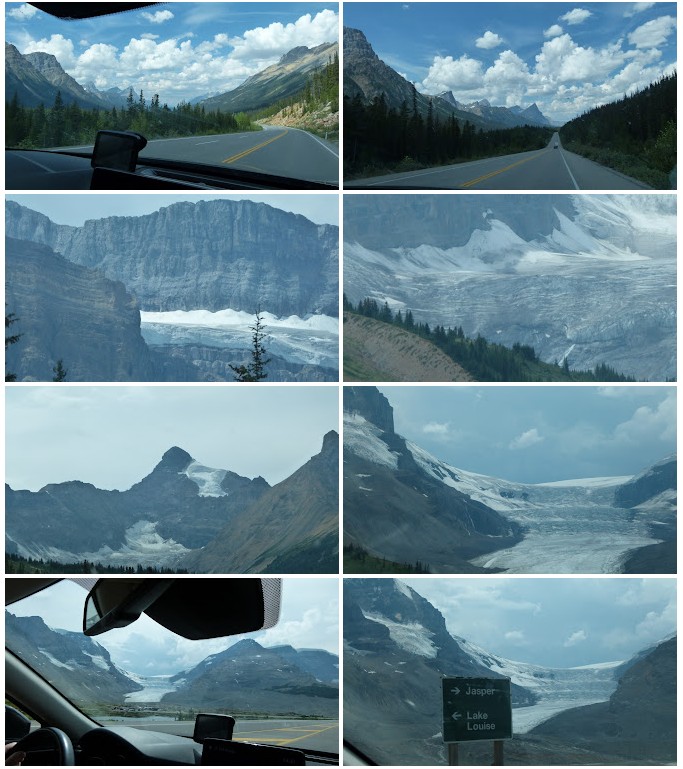
It's obvious that, in summer, the glaciers are melting and the melt water is cascading away at their feet. But are they being fully replenished higher up by winter snow?
Well, no they're not. At the present melt rate glaciologists reckon that, like us, they will all be gone before the end of this century. So, it was good to see them now.
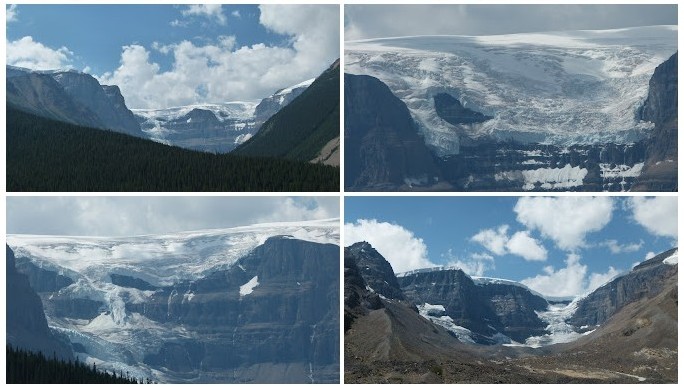
In addition to being another ski resort, Jasper is a rail-head into which very long tourist and cross-country trains slide. The station hall features a huge, good and truly stuffed, grizzly bear in a glass case. He was 'stuffed' for the first time when, distracted by doing whatever it is that bears do in the woods, he failed to notice a hunter. The taxidermist simply finished the job.
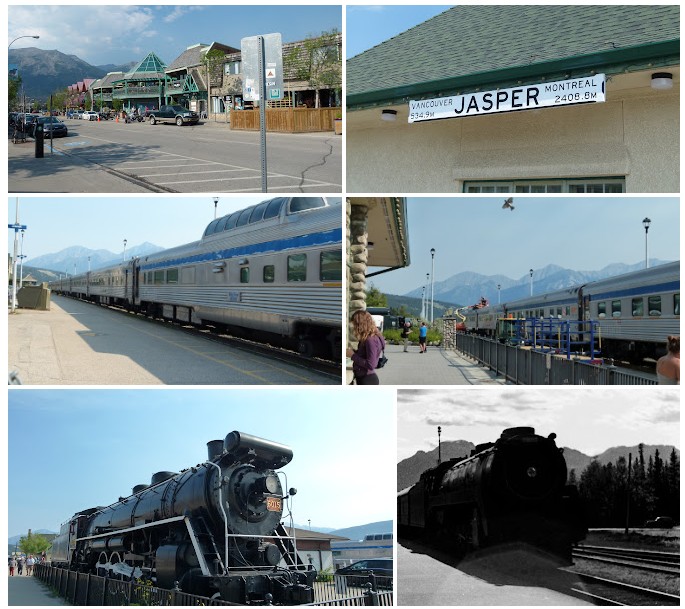
The black engine in the snow was photographed by my father, Stephen McKie, circa 1943, He'd got some sun in his lens.
The older Canadian Pacific Railway locomotive is on display at the station.
This engine caused me to recall the 'Ballad of Eskimo Nell' in which the pistons of the C.P.R
are likened to Deadeye Dick's sexual prowess (no match for Nell as it turns out).
How is this still in my head?
Yet, the world has changed since I was amused by such bawdy smut, me too.
Shale deposits, like these (lower left), are sedimentary and were, obviously, laid-down horizontally, around half a billion years ago. Since then, they have been raised and tilted and are still moving, imperceptibly, without very sophisticated measurement, to us short-lived humans.
Since 1901 the Burgess Shale deposit, not far from here, has been under intense study as it contains unique soft-tissue fossils from the earliest animals Earth. Click on the image above to learn more.
Can anyone still believe the Biblical creation myth?
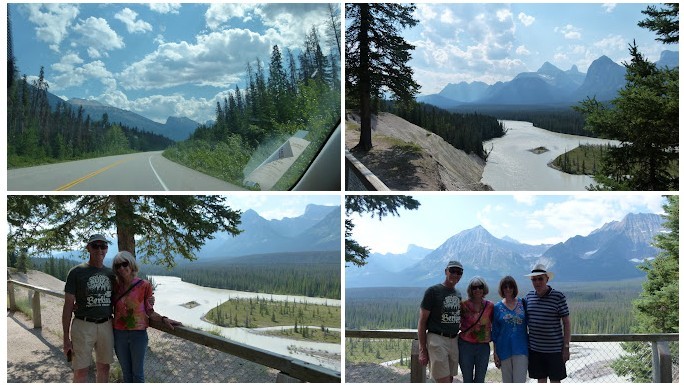
Our next stop would be Calgary where we would say farewell to Brian and Kat. A pity, as they are excellent travel companions. Brian and I have known each other since 1972 in Australia; then in the UK; and then in the US; each on numerous occasions, and have always enjoyed sharing ideas. Kat and Wendy hit it off the moment they met.
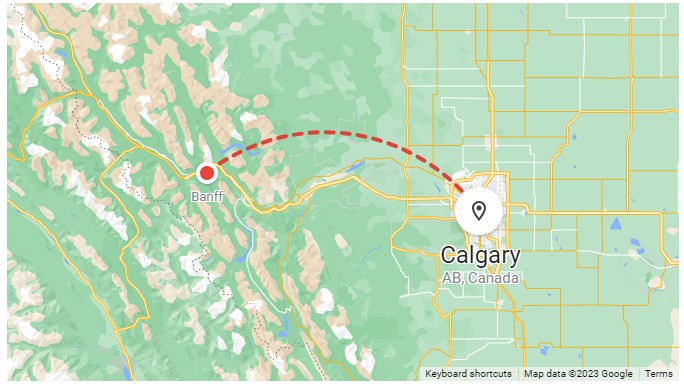
As we arrived in Calgary, I couldn't believe my eyes.
I'd been here in 1975, when it was little changed from the photographs in my parent's album, see below. Now it's the fourth biggest city in Canada, with close to 1.5 million residents, and it is the wealthiest, thanks to oil. It was a bit smoggy though.

As I mentioned earlier, my parent's first married home was here. The arial photos below are in their Canadian album. The first is of a Canadian Hudson Trainer flown by my father or his student? It's obviously taken from a second plane off his wing.
The second is Calgary from the air, possibly a publicity shot. I imagined my father had taken it but I found exactly the same image on the web and it's too fine-grained for his camera.
According to 'Calgary Then and Now', the tallest building back then was the Palliser Hotel at 12 storeys. By 2021 the tallest building was the Brookfield Place Tower with 56 storeys (247 metres). There are now dozens of buildings above 30 storeys tall. It's worth noting that Canada, like Australia and New Zealand and even South Africa, has managed to abandon Imperial measurements, while across the border, in the US, it's all too hard.
Below, is where my parents made their first home. When I visited Calgary in 1975, it looked very much the same as in 1943. They had a flat that was below the house. I've mislaid the photo I took back then. Now the house is gone.
Yet, the neighbouring houses are still there and the street is scaped and leafier.
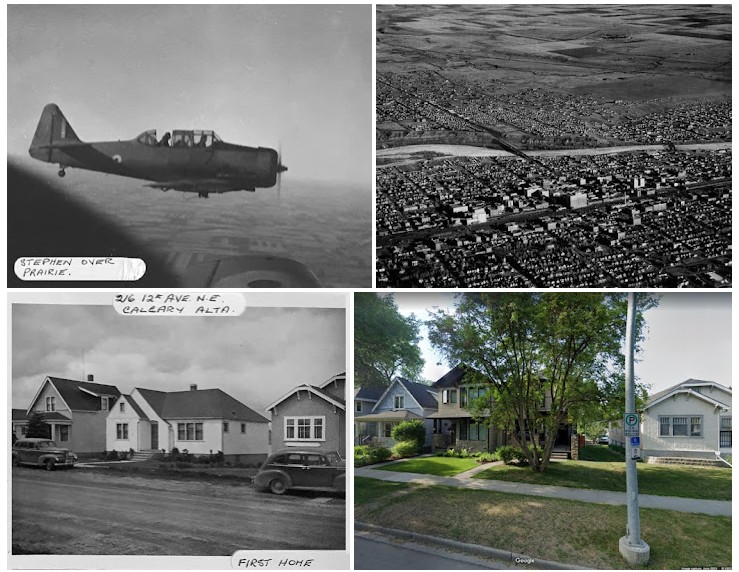
From Calgary airport we caught an afternoon flight to Toronto.
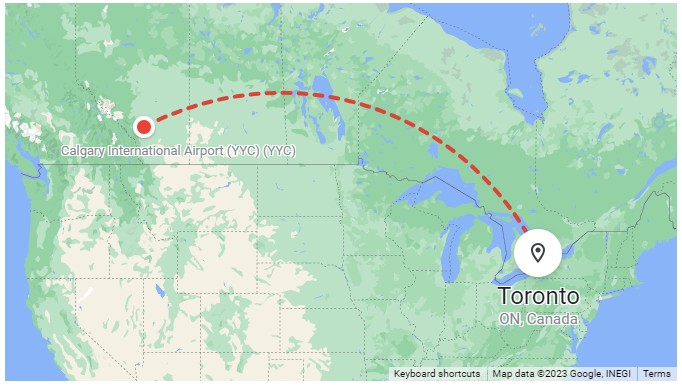
There is a lot to see in Toronto.
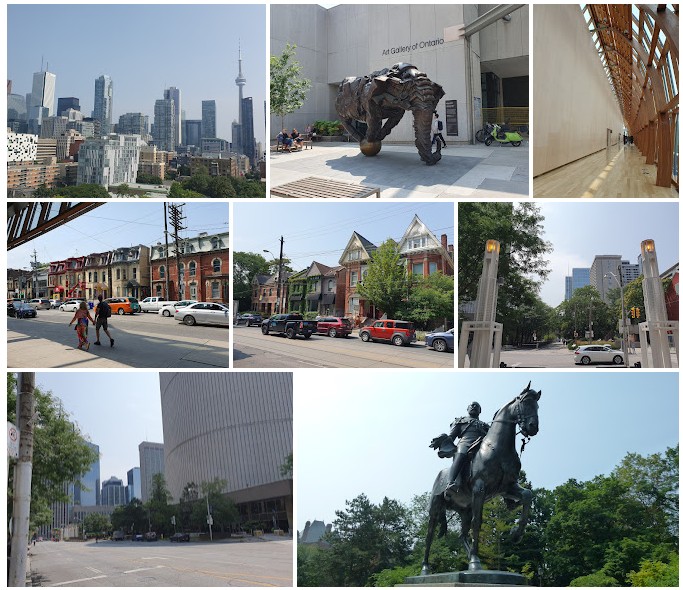
Canada has quite a bit in common with Australia. Indeed, across Canada, except in Quebec, when sitting in bars and caffes and overhearing the accents of the staff, you might be tempted to think that you are in Australia. Many of them seem to be staffed exclusively by back-packing Australians.
We are, of course, both constitutional monarchies, and share the same, remote, royal family. So, I was not surprised to encounter a large equestrian statue of Edward VII in Queens Park, as Sydney has a similar one in Macquarie Street - hat on head - sun aware.
The mystery here is that this one has an elaborate convex tablet in front proclaiming: that it was: placed here, in Delhi, by King George V Emperor of India (for the Coronation Dubar 15 December 1911).
This required an explanation.
It turns out, that is once stood before the Red Fort in Delhi and has been moved half way around the world.
It's like the statue of Queen Victoria, between the Town Hall in Sydney and her eponymous Building, that came from Ireland when she became anathema there. Like the ungrateful Irish, the Indians didn't want a remembrance of dead Edward anymore; nor his son's tablet proclaiming himself Emperor.
Thus, Toronto also has this in common with many Australian cities, in that in a park you may well encounter, in effigy, some long dead King, and recently, yet another dead Queen.
Interestingly, it transpires that Emperor George V was euthanised, some say murdered, probably without his consent, after his wife, Queen Mary, and his son, soon to be Edward VIII, explicitly told the king’s physician, Lord Dawson, that they did not want the King life needlessly prolonged if his condition was fatal. Dawson promptly filled his syringe and George was gone before the evening papers went to press (read more...). George's last words were said to be: “God damn you!” This was discovered in 1986 when Dawson's diary, giving his account of the circumstances, was made public.
I was immediately reminded of Liza (Eliza) in Pygmalion (My Fair Lady) telling Mrs Eynsford Hill about the death of her aunt, who had promised her a hat:
Liza: My aunt died of influenza: so they said... But it's my belief they done the old woman in.
Mrs Eynsford Hill: You surely don't believe that your aunt was killed?
Liza: Do I not! Them she lived with would have killed her for a hat-pin, let alone a hat.
Like other great cities, in addition to parks, Toronto has numerous museums and art galleries.
There's far too much to see in the Art Gallery of Ontario for me to show here, not that I photographed more than one in twenty, so I've given you just one picture here. It's worth seeing for the building alone.
If you click on Luisa, you'll see some other photos I took in the gallery.
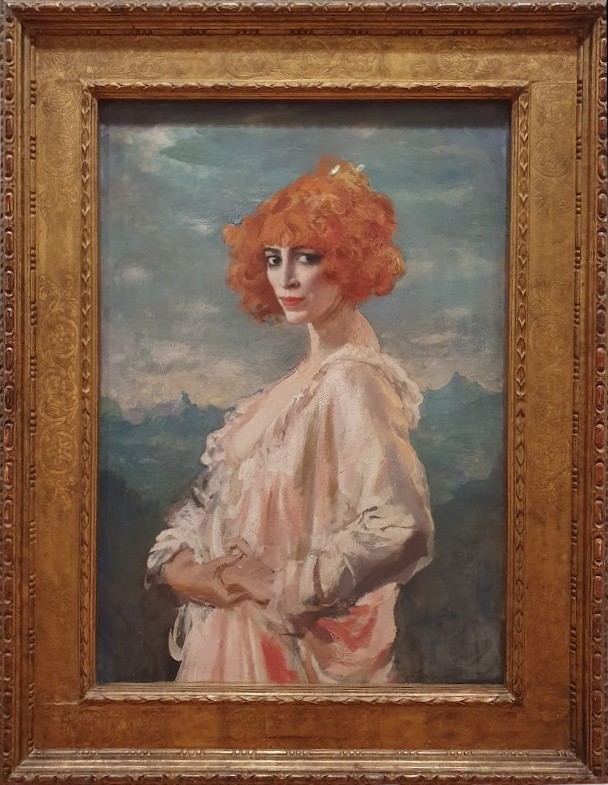 The Marchesa Casati (Luisa) by Augustus John 1919 - oil on canvas
The Marchesa Casati (Luisa) by Augustus John 1919 - oil on canvas
Again, the Royal Ontario Museum, in Queens Park, Toronto, is vast with a very eclectic catalogue, ranging from dinosaur and megafauna skeletons to fully furnished rooms and objet d’art. So, again, if you are interested in a little sample, click on the picture below to see some of the photos I took.
Standouts, for me, are the many ways, some incredibly bizarre, in which humans attempt to pass into an imagined an obviously mythical 'afterlife' when they die. Among these are the Museum's big Egyptian, ethnic and western/eastern collections, dedicated, to one degree or another, to the same futility. But the most unusual is to go to the next world in a Mercedes Benz coffin.
| "Oh Lord, won't you buy me A Mercedes Benz? My friends all drive Porsches I must make amends..." If dead people, like Janis, have clothes in the next world, maybe they also have other manufactured goods, like German cars and TV sets? |
After a very pleasant stay in Toronto it was time to get a car, this time from Billy Bishop Toronto City Airport on Toronto Island. There's a pedestrian tunnel to get there but no road tunnel. So, I had been wondering how the rental cars got in and out. This was disappointingly conventional, it just required taking a car-ferry to the mainland. Yet, it was a small adventure in itself.
Now we had a real car, not a wooden Merc, it was time to get on with our travels:
| "Let's go again to Niagara, this time we'll look at the falls... " A travel 'bucket list' - a couple more to check off |
Niagara Falls is a short excursion from Toronto, an easy day trip.
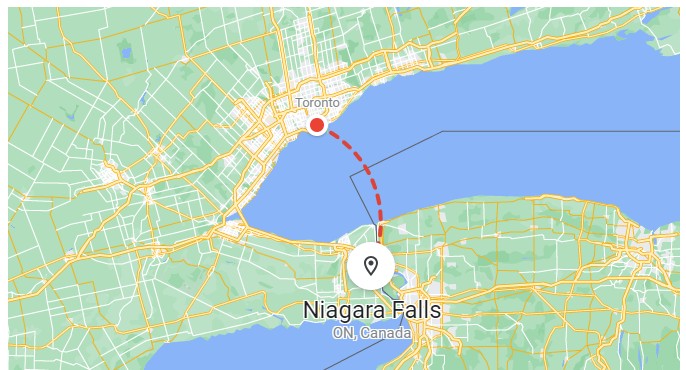
Unfortunately, we got caught up in an interminable traffic queue, waiting to cross the US border, one car every ten minutes, or so it seemed. If I hadn't left the road and taken off over the grass we'd be there still (it was a fully insured rental).
We've both been to Niagara before, in pervious lives, and as we've just been to Victoria Falls (see here...) and earlier been to Iguassu (see here...), we knew what to expect. But we like big waterfalls, they still impress us, up close and personal.
In this case, it's a great lake pouring over a cliff. Spectacular. If you haven't been - go.
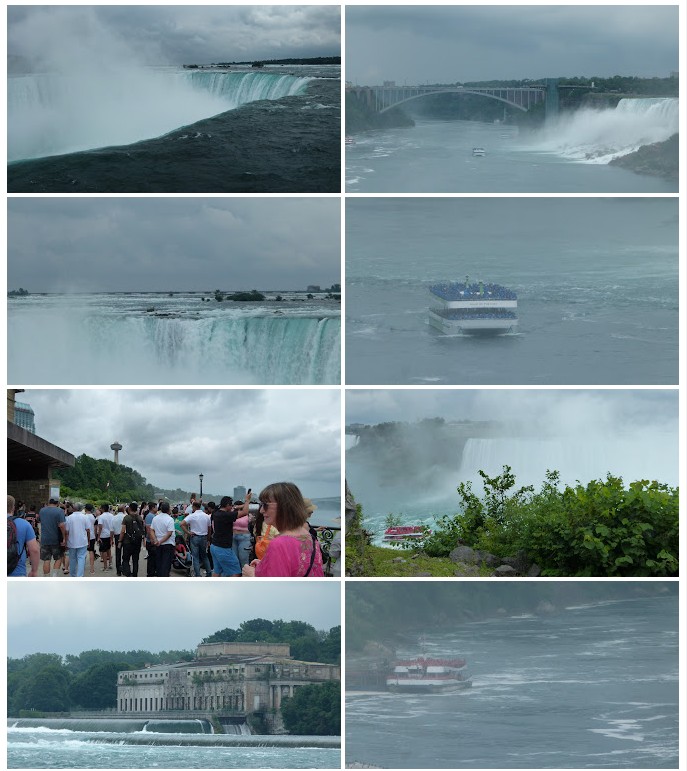
What didn't impress was the crush of people, pushing in front and waving an arm across the lens, pointing, just as you took a photo. The world is definitely getting ridiculously overcrowded. In the end, we didn't stay long and set out for Kingston, well before dark, ready for our drive to Ottawa the next day.
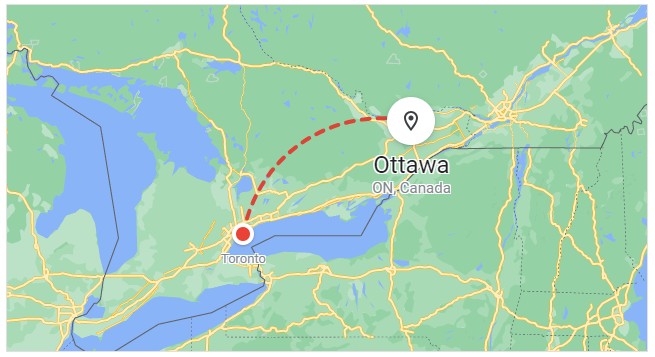
In Ottawa, the centre of National government, it was raining heavily. We'd booked a tour of the Senate and almost missed it as the Parliament building is being renovated and the Senate temporally resides in what was an historic railway station, several blocks away. We both, separately, got soaked.
A young guide took us around. She explained that, as in Australia and the US, Senators are Provincial (State) Representatives. But here they are not elected but are appointed by the Governor General, who, she explained, until recently represented the Queen, who's initials were ER because, according to our young guide, her second name was Regina.
I thought it my duty, both to our present tour guests; and to our guide; to politely correct her. She was quite taken aback. She takes several tours a day, no doubt imparting the same information. I'm still not sure she believed me when I informed her that 'Regina' means Queen and, now, Charles is Charles Rex. Silly old bugger!
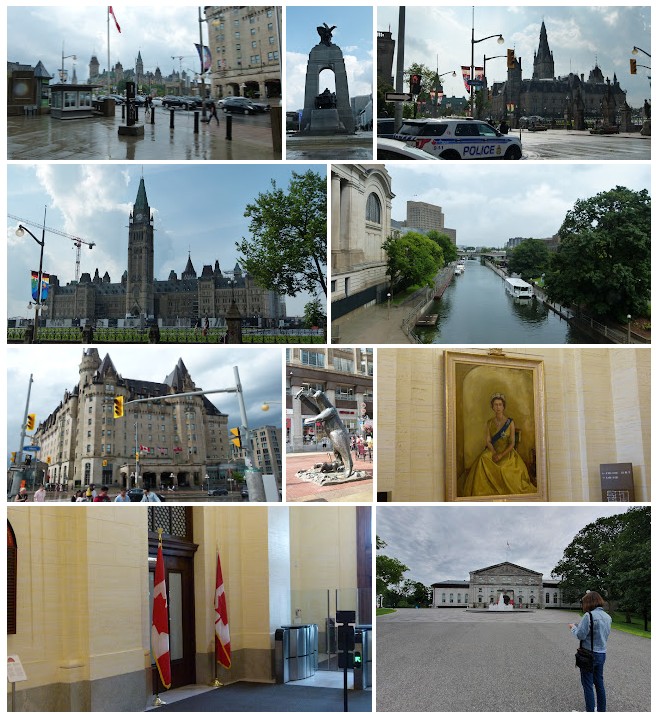
Before leaving Ottawa, we nipped over to the Governor General's residence for a quick visit. It's perhaps a bit grander than Yarralumla. And the guard is very British looking. Except that one was a woman.
The surrounding park is extensive and contains trees planted by visiting dignitaries (a pun?) as well as objects, like an interesting totem.
Mary Simon, the current GG, wasn't home so we left and drove to Montreal.
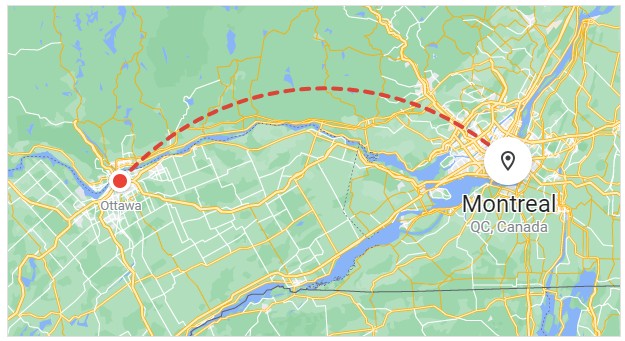
Montreal is hosting a comedy festival called Juste Pour Rire (just for laughs).
As everyone here has French as their first language and I remember being totally bemused by a comedian in Paris, I judged that we might not laugh if I bought tickets.
As part of the Juste Pour Rire festival, Montreal is staging a live version of 'The Adams Family' (understandable) but also Hair (the hippie rock musical). As I recall, having seen Hair a couple of times, it's not a huge barrel of laughs, even in English. I told you that the French have an odd sense of humour.
But the city is very nice to walk around on a lovely Sunday. Sometimes it was easy to imagine that we'd been transported to some exotic part of Paris. The giveaway is that Paris has more signage in English; and more anglophones in the street. In most of Canada signs are bilingual. Yet, not here - only French.
I went into a coffee shop near the Latin Quarter and discovered that the waitress doesn't speak any English. She wasn't pretending. In Montreal there is no need. And we did perfectly well without English.
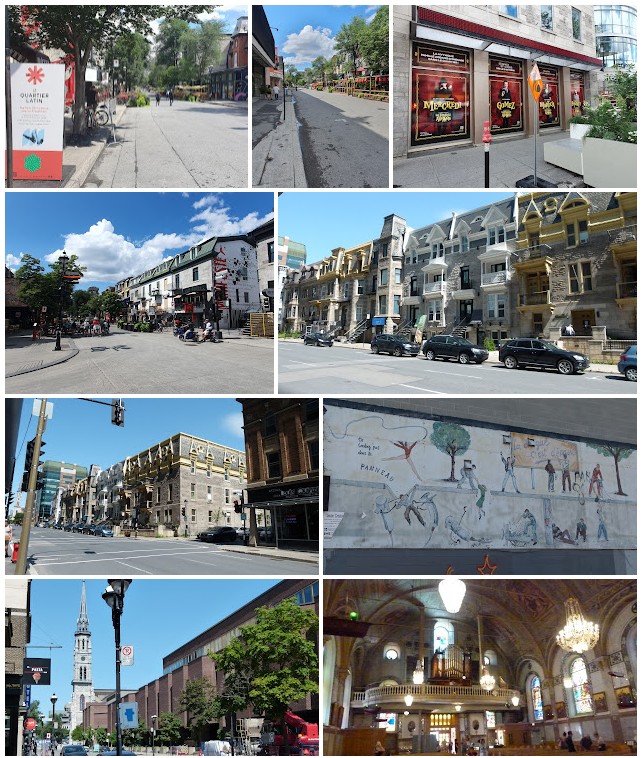
In the same street as our hotel, we came upon the oldest chapel in Montreal: the Notre-Dame-de-Bon-Secours Chapel.
It was here that Marguerite Bourgeoys set up the first school and founded an uncloistered convent. She wasn't so popular back then. Now her dodging excommunication stands as a feminist victory.
So, after only 282 years she was finally canonised, by John Paul II. In 1982 she became Canada's first female saint.
Mary McKillop, Australia's first, also by JPII, was a bit quicker, in a third of that time.
The Chapel is also known as the sailor's church and little boats are suspended over the nave. It operates both as a church and as a museum.
It was Sunday and we half expected a service to be underway or at least someone reciting the rosery. But a young, English speaking, female guide explained that the congregation had shrunk dramatically over recent years so that Mass, that morning, had been attended by fewer than a hundred worshipers.
She explained that this was most dire in Montreal due to the Church's perceived role in oppressing the French speaking community!
I suggested that clerical abuse might also be a factor. "That too," she conceded.
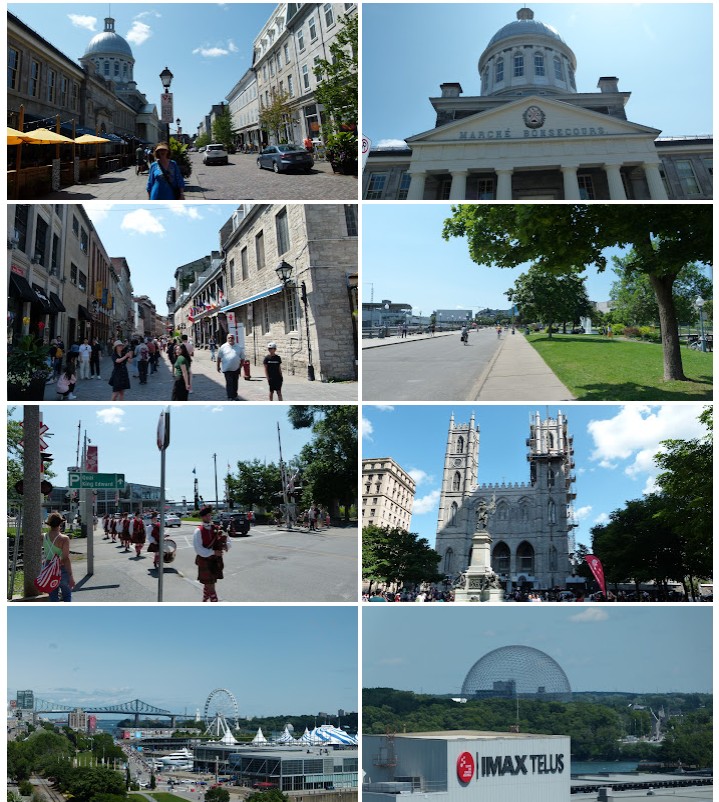
At the Montreal Museum of Archaeology and History there is an Egypt exhibition where we were again reminded that for thousands of years mankind needed many gods, to explain the presence of evil, to sustain agriculture, to cure the sick, and to cause phenomena, like weather and tectonics. But most importantly: to provide for the dead in eternity. Egyptians liked to take their pets and even servants with them. So the Mercedes coffin to carry one into the life beyond, we saw in the Royal Ontario Museum in Toronto looks very reasonable by comparison.
Who remembers Expo 67? From the Museum of Archaeology, the geodesic dome is still visible. As are many new buildings constructed since.
In the cathedral square there are two bronze satirical statues with grotesque faces and ridiculous clothes. Both are carrying (French) poodles.
The explanatory plaque explains that they are English, the caricatures, not the dogs. Try swapping the nationality with any other and see how long they last.
I'm not sure that the Francophones of Montreal are fully reconciled to being Canadian.
To see the remaining photographs (not already linked above) click on the image below:
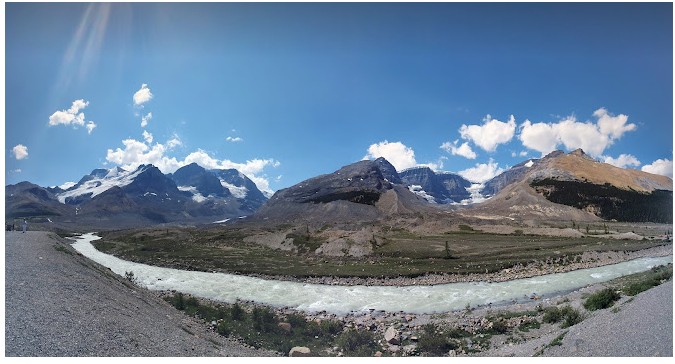 Glacial meltwater Jasper National Park
Glacial meltwater Jasper National Park

